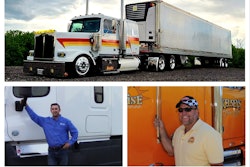Bonus plans can make a big difference to drivers’ bottom line.
In these days of an improving economy, more freight and new hours-of-service rules, truckers seeking new employment can get higher-than-ever sign-on bonuses.
“Currently, about 26 percent of the pay packages we surveyed offer sign-on bonuses for new drivers,” says Gordon Klemp, president of the National Survey of Driver Wages. Among the highest, “there are three at $5,000 paid out in the first year, and there’s one at $7,000 paid out in the first year,” he adds.
But drivers don’t need to switch jobs to cash in on bonus options. They can earn thousands of extra dollars each year by taking advantage of their companies’ bonus programs. Fleets offer bonuses as incentives for drivers to conserve fuel, drive more safely, haul more freight and refer other drivers for hiring.
The idea is simple – do the extras the company asks for and be rewarded for them.
Safe and sound
Edwin Coleman of Tyler, Texas, company driver for four years with American Eagle Trucking in Lancaster, Texas, earns an extra $300 every three months by qualifying for the company’s safety bonus. “It averages out to a little over a penny a mile,” he says.
The deal is straightforward enough. If drivers don’t have any tickets or preventable accidents for the three-month period, the company will pay them a bonus.

Boyd Bros. Transportation also emphasizes safety to its drivers, says Wayne Fiquett, human resources and safety director at the Clayton, Ala.-based company. “We just tell them safety is our No. 1 priority,” he says. “If they’re safe and they keep their miles per gallon down, there’s money in it for them.”
For the past eight years, Gary Barr of Richmond, Va., has driven for Abilene Motor Express, also of Richmond. The company offers bonuses of a half penny per mile for safe drivers. “My average safety bonus checks come to about $500 a year,” Barr says.
Referrals
Abilene Motor Express also pays $500 for referrals. “If I can get one person a year for referral plus my safety bonus, that’s an extra $1,000,” Barr says.
U.S. Xpress Vice President Gary Kelley says he prefers paying his drivers for finding new hires rather than paying for traditional advertising. U.S. Xpress offers a $750 driver referral bonus that pays in full “after the new driver is with us 90 days,” Kelley says. “Some U.S.X. drivers have become great recruiters, even to the extent of taking out ads in newspapers. If a driver sends me 10 good recruits a year, that’s an extra $7,500, and we’re both happy.”
Owner-operator Richard Skoglund of Payson, Ariz., who is leased to Marten Transport in Mondovi, Wis., has his own way of cashing in on that company’s $1,000 referral bonus. He carries referral cards. “They’re made of heavy paper,” Skoglund says. “One side is for owner-operators; the other is for company drivers.” The cards list the benefits Marten offers. “I carry five or six of them on me all the time and hand them out to drivers who are complaining about their jobs.” Marten pays the bonus in a lump sum as soon as the new driver is dispatched on a load.
Skoglund has also collected on Marten’s safety bonus – $200 paid quarterly to drivers with no accidents, incidents or citations for the period, and who have watched the assigned safety video. “But the referral bonuses are where the real money is,” he says.
The money drivers can make from referral bonuses is for real. “Last year we paid out over $280,000 in referral bonuses alone,” says Richard Snyder, recruiting chief for Crete Carrier Corporation in Lincoln, Neb. Crete offers bonuses of up to $500 per quarter for safety and mileage, but “our driver referral bonus is huge,” Snyder says. “It’s one of the best things we have out there for a recruiting tool.”
This is important to carriers since most truckstops no longer allow them to recruit on premises. “It was threatening their business,” Snyder explains. “Other trucking companies complained about sending their drivers in for fuel and having them recruited away by the competition.” This eliminated the best way for company recruiters to talk face-to-face with a lot of experienced potential recruits. But other drivers can still recruit there, and many use business cards with cell phone numbers on them.
“They have the advantage over our home office recruiters because they are right there with the potential hires,” Snyder says.
Crete also encourages new drivers to bring along their friends to orientation. “We’ll pay $500 at orientation for each recruit a driver brings in and $500 more after 90 days, if both drivers are still with us,” Snyder says.
Snyder says most of the turnover in the industry occurs within the first 90 days a driver is at a job, so the bonus is intentionally designed to keep new hires there for at least that long.
Paschall Truck Lines’ record $7,000 sign-on bonus for owner-operators pays off over nine months; their $1,500 sign-on bonus for company drivers pays off over 90 days. To earn the $5,000 sign-on bonus at U.S. Xpress, drivers must stay with the company a year. “Our bonuses are pretty much incentive based,” Kelley says. “The extended payoff acts as an incentive for drivers to stay with us for at least that year.”
This might be a sticking point for some drivers. “A lot of them offer large bonuses,” Barr says. “But they pay them out over time, so you still have to work your butt off to get them.”
Boyd Bros.’ driver recruiting bonus has an interesting twist that helps drivers benefit by increasing retention and keeping turnover rates down. “If someone is referred to us and signs on, the driver who referred him gets a half penny for every mile the new hire drives, for as long as he drives with the company,” Fiquett says.
But the industry’s inability to attract and hire good people is a bigger issue than retention, says Terry Weaver of TruckFLIX.com in Granby, Mo. “There have always been bonuses to attract new people and bonuses for retention purposes,” he says. “There has been a noticeable increase in the use of bonuses and in their dollar amounts in the last few months.”
Companies that are experiencing acute driver shortages or that have opened new accounts in an area might offer larger bonuses to fill those seats. “If we have a new startup of a dedicated route someplace that we need to fill in a hurry, we will offer a $2,500 sign-on bonus. For example, I could use 25 drivers in Ohio, so we have a $2,500 bonus for drivers who sign there.”
Marten Transport has increased pay for its two-and-a-half day orientation from $200 to $500 “to give drivers a little more incentive to get in here,” says recruiting director Stacia Dewitt.
Save the company money
Bonuses are also offered for productivity and saving fuel.
Marten offers company drivers a $500 “productivity incentive bonus,” paid in one lump, to those who drive more than 30,000 miles in one quarter. “Teams have to drive 60,000 miles, but they get $500 each,” Dewitt says.
She also described an incentive Marten offers to owner-operators. “We do give 100 percent of the fuel surcharge back to owner-operators,” she says. “The base right now is set at $1.17. For every seven cents fuel goes above that rate, the driver gets an extra penny per loaded mile.”
Marten company driver Jim Franklin, who gets his mail in North Carolina but calls his truck home, was the recipient of a special bonus: a quarterly drawing he won for $2,500. To qualify for the drawing, he had to earn the fuel bonus three months in a row. “They throw your hat in a barrel along with all the other people,” Franklin says, “and I won.”
Drivers who keep their idling below 40 percent are awarded a 2 percent bonus every month. “When they pay you a fuel bonus, you learn not to run your truck,” Franklin says. “They get your attention. When you go in to eat or something, you usually leave your truck running. But when they pay you a fuel bonus, you learn to shut it off.”
Home is where the heart is
While bonuses are a big lure, more time at home might just be the incentive drivers are looking for most.
“We try and stress to the drivers to fill out the comment section on our applications, and almost every driver wants to be home on the weekends,” says Lee Rogers, owner of All-Trucking-Jobs.com. From what Rogers has seen, carriers are responding to this need. “Almost every carrier is saying, ‘We will get you home,'” he says. “One California company is saying, ‘We will get you 2,700 miles a week and get you home on weekends.'”
U.S. Xpress’ Kelley says his company is offering higher sign-on bonuses of $5,000 to drivers who live in areas where it’s easier to get them home. “These bonuses are for people who live in the Midwest – places like Illinois, Indiana, Ohio and parts of Wisconsin,” Kelley says. “The Midwest is our best place for getting our drivers home, so that’s why we offer the bonus there.”
Kelley explains that U.S. Xpress fleet managers are held accountable for the number of miles and amount of home time drivers get, and it’s harder to get drivers home if they live in places not near major freight routes. “If he or she lives in Columbus or Indiana, or someplace in the middle of the country, it’s easier for us to get him home.”








